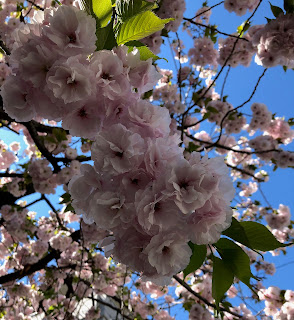--Susan, every other Sunday
Seasonal foods are one of the (admittedly, countless) things I love about living in Japan.
 |
| An autumn dinner in Yuasa, Wakayama Prefecture |
Everything from restaurant menus to grocery stores, and even the items on display at conbini (Japan's omnipresent, supercharged convenience stores) changes radically with the turning of the year--and not just quarterly.
Some of the older, more traditional restaurants and teahouses recognize 24--and in extreme cases, 72--different seasons in every year. These exceptionally detailed seasons relate to the relative positions of the earth and sun, and have an impact on which crops are most "in season" at any time of year.
 |
| The components of this traditional breakfast (it's a savory meal in Japan) change weekly--if not more often. |
This week (March 14) falls near the middle of Keichitsu, which is the seasons "where hibernating insects awaken and show themselves." (Fortunately, this does not include cicadas--which get their own season, in early July.)
 |
| Winter breakfast. No bugs allowed. |
March is also the time when Japanese people turn their thoughts--and palates--from ume (plum) blossoms to their more internationally-renowned counterparts: the sakura. And, as always, where the thoughts of Japanese people go, the menus follow.
 |
| Sakura - Ueno Park, April 2019 |
March is "all-sakura-all-the-time" season when it comes to specialty foods--some of which are admittedly stranger than others. Unfortunately, as my son will gladly tell you, far too many sakura-flavored items "taste like a mixture of cough syrup and soap."
However, since I'm on a year-long quest to sample a new food every day for a book I'm writing about culinary adventures in Japan, it seemed like a good opportunity to see whether I could bust the myth that sakura flavored foods are merely soap-and-cough-syrup-flavored hype and see whether any are actually delicious.
As it turns out, the task was easier than expected. Here are just a few of the sakura treats on offer in Tokyo this year--and I can happily confirm that (to my great surprise) most of them were actually quite tasty:
 |
| Sakura Dacquoise - more salty than sweet, and vaguely soapy, but it did have bits of real sakura blossom in it. Probably won't buy it again, but I'm glad I tried it. |
 |
| At the conbini - Starbucks "sakura milk with strawberry jelly" For the record, this one DID taste like soap. |
 |
| Sakura Okoshi - a traditional snack made with puffed rice and peanuts. Very light, naturally floral flavor. 10/10 will eat annually. |
 |
| "Sakura latte with warabimochi" (bracken root dumplings) The least artificially colored, and one of the tastiest of the bunch. Also, I love warabimochi. |
 |
| It wouldn't be Japan without a sakura kit-kat. Did NOT expect to like this--file it under "biggest surprise" because it was actually pretty good. |
 |
| The undisputed winner so far: sakura blossom and white chocolate scone from a local bakery Yes, that's a real pickled flower on top, and there were more inside. |
 |
| Starbucks is famous for its seasonal offerings in Japan. This is the "sakura-berry Frappuccino" Unlike the mass-produced conbini offering, this one is actually quite tasty. |
Sakura season has just begun here in Japan--the first large areas of blossoms were sighted in Kyushu last week, and at last report, Hiroshima Prefecture's cherry trees have begun to bloom as well. The trees here in Meguro (southern Tokyo) are setting buds, and I'll be watching them like a hawk on my daily walks from point on, though I don't expect to see them blooming for another two weeks or so.
The sakura-flavored-food season will continue to surge through the sakura bloom, and die off just as quickly when the blooms are gone--by mid-April at the latest. At that point, the summer treats will start to appear.
But, for the moment, cherry blossoms reign supreme.
So, tell me: cherry blossom foods. Are you in, or is this one a pass for you?


I would try it. Especially the Kit Kat!!
ReplyDeleteI'm always willing to try anything. The scone looks delicious.
ReplyDeleteStan, the scone is absolutely filed under "will feel objectively sorry when this is gone for another year" -- which is not usually the case with spring desserts, given my preference for the chocolate-mint items that show up here in the summer.
DeleteAre these treats generally as heavily sugared as in the US?
ReplyDeleteFortunately, no, Kwei--at least not for the most part. Japanese sweets tend to fall into two camps: half-to-less sweet as their counterparts in the US, and "instant diabetes." The former are far more common - I'd say well over 75% of the desserts here are what Japanese people sometimes call "adult sweetness" - which means lightly sweetened, rather than sugar bombs (which are seen as "children's desserts"). Of the ones above, only the KitKat was notably sweet--and even that wasn't "child" levels (probably because sakura desserts are largely marketed to adults as well as children).
DeleteWoe is me, Susan. Considering the number of allergies I have, and considering that many of them are to fruits from trees that pollinate in the spring, including cherries, I would have to pass on most of the sweets. And then there is the soy.... BOOHOO!
ReplyDeleteSadly, I think you're right. Oh well. I will eat them for you!
DeleteI'm in! Except I will avoid the soaps. Cilantro tastes soapy to me.
ReplyDeleteLiving as you do in dessert fantasy land, Susan, I understand why you hike a different mountain every day! I'd have to hike two.
ReplyDelete